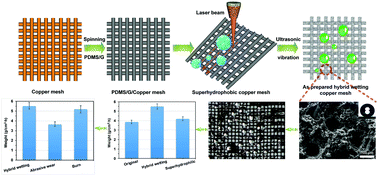A bioinspired structured graphene surface with tunable wetting and high wearable properties for efficient fog collection†
Abstract
Inspired by the fog harvesting ability of the spider net and the interphase wetting surface of Namib desert beetles, we designed a kind of special bioinspired hybrid wetting surface on a Cu mesh by combining polydimethylsiloxane (PDMS) and graphene (G). A surface containing hydrophobic and superhydrophobic areas is prepared by a combination of laser etching and ultrasonic vibration. Thus, this as-prepared hybrid wetting surface can quickly drive tiny water droplets toward more wettable regions, which makes a great contribution to the improvement of collection efficiency. Moreover, the PDMS/G surface not only is tolerant to many stresses such as excellent anti-corrosion ability, anti-UV exposure and oil contamination, but also shows self-healing simply by burning the worn areas, which thus endows the surface with tunable-wettability change between flame treatment and abrasive wear. This study offers a novel insight into the design of burned healed materials with interphase wettability that may enhance the fog collection efficiency in engineering liquid harvesting equipment and realizes renewable materials in situ cheaply and rapidly by processes that can be easily scaled and automated.



 Please wait while we load your content...
Please wait while we load your content...